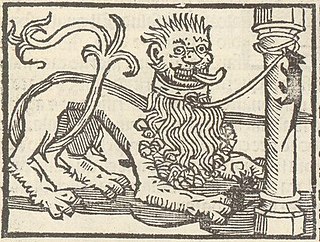
Fable is a literary genre defined as a succinct fictional story, in prose or verse, that features animals, legendary creatures, plants, inanimate objects, or forces of nature that are anthropomorphized, and that illustrates or leads to a particular moral lesson, which may at the end be added explicitly as a concise maxim or saying.

Aesop's Fables, or the Aesopica, is a collection of fables credited to Aesop, a slave and storyteller who lived in ancient Greece between 620 and 564 BCE. Of varied and unclear origins, the stories associated with his name have descended to modern times through a number of sources and continue to be reinterpreted in different verbal registers and in popular as well as artistic media.

"The Tortoise and the Hare" is one of Aesop's Fables and is numbered 226 in the Perry Index. The account of a race between unequal partners has attracted conflicting interpretations. The fable itself is a variant of a common folktale theme in which ingenuity and trickery are employed to overcome a stronger opponent.
A fable is a story intended to illustrate a moral.

The Fox and the Grapes is one of Aesop's Fables, numbered 15 in the Perry Index. The narration is concise and subsequent retellings have often been equally so. The story concerns a fox that tries to eat grapes from a vine but cannot reach them. Rather than admit defeat, he states they are undesirable. The expression "sour grapes" originated from this fable.
Sour Grapes may refer to:

A bedtime story is a traditional form of storytelling, where a story is told to a child at bedtime to prepare the child for sleep. The bedtime story has long been considered "a definite institution in many families".

The Lion and the Mouse is one of Aesop's Fables, numbered 150 in the Perry Index. There are also Eastern variants of the story, all of which demonstrate mutual dependence regardless of size or status. In the Renaissance the fable was provided with a sequel condemning social ambition.
The Fox and the Crow may refer to:
A talking donkey is a type of talking animal; in this case, the animal is a donkey. Examples include:

The Fox and the Crow is one of Aesop's Fables, numbered 124 in the Perry Index. There are early Latin and Greek versions and the fable may even have been portrayed on an ancient Greek vase. The story is used as a warning against listening to flattery.

Aesop was a Greek fabulist and storyteller credited with a number of fables now collectively known as Aesop's Fables. Although his existence remains unclear and no writings by him survive, numerous tales credited to him were gathered across the centuries and in many languages in a storytelling tradition that continues to this day. Many of the tales associated with him are characterized by anthropomorphic animal characters.

The Lion & the Mouse is a 2009 nearly wordless picture book illustrated by Jerry Pinkney. This book, published by Little, Brown and Company, tells Aesop's fable of The Lion and the Mouse. In the story, a mouse's life is a spared by a lion. Later, after the lion is trapped, the mouse is able to set the lion free. Adapting the fable, with the moral that the weak can help the strong, as a wordless picture book was seen as a successful way of overcoming the brief plot generally found in the source stories. While it was Pinkney's first wordless picture book, it was not the first time he had told the story, having previously included it in his Aesop's Fables, published in 2000. Pinkney, who had received five Caldecott Honors, became the first African American to win the Caldecott Medal for his illustrations in this book. His illustrations were generally praised for their realism and sense of place. The cover illustrations, featuring the title characters but no text, drew particular praise.
The Lion and the Mouse is one of Aesop's Fables.

The Dove and the Ant is a story about the reward of compassionate behaviour. Included among Aesop's Fables, it is numbered 235 in the Perry Index.
The Tortoise and the Hare is one of Aesop's Fables.

Hercules and the Wagoner or Hercules and the Carter is a fable credited to Aesop. It is associated with the proverb "God helps those who help themselves", variations on which are found in other ancient Greek authors.

Aesop's Fables is a 2000 collection of 61 fables from the Aesop oeuvre, retold by Jerry Pinkney. It includes stories about wolves, foxes, lions, dogs, mice, and donkeys.

The Grasshopper & the Ants, by Jerry Pinkney, is a 2015 adaptation of the classic Aesop fable where a grasshopper relaxes through Spring, Summer, and Autumn, while a colony of ants work at gathering food for the Winter, but although initially refusing the grasshopper's request for help, they relent and invite him in to share.

The Tortoise & the Hare is a 2013 wordless picture book of Aesop's classic fable and is illustrated by Jerry Pinkney. It is about a tortoise and a hare that compete in a foot race with the tortoise surprisingly winning.
This page is based on this
Wikipedia article Text is available under the
CC BY-SA 4.0 license; additional terms may apply.
Images, videos and audio are available under their respective licenses.













